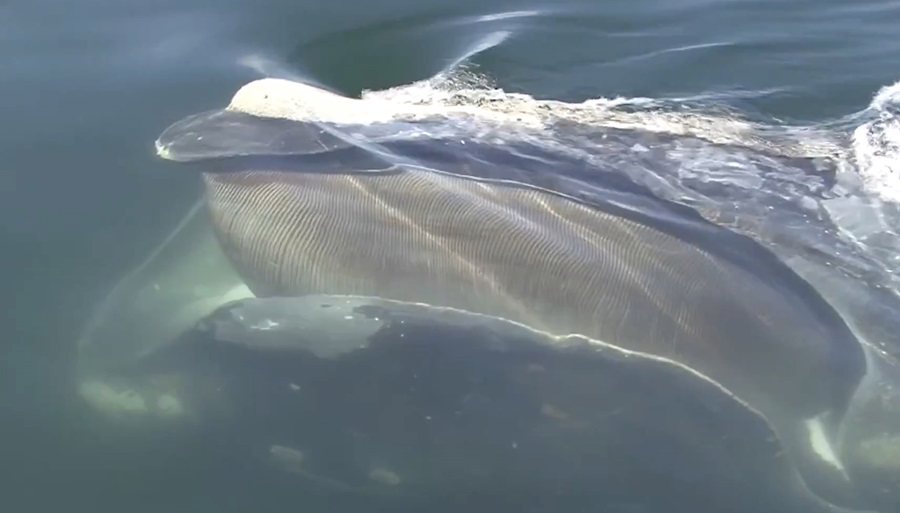Spring is in the air on the Outer Cape. If you don’t believe me, just ask the whales and the stripers.
The right whales are in Cape Cod Bay now, munching on the plankton bloom that occurs every spring, with the area off Herring Cove and Race Point being the hot spots to see them from land. Park your car in the Herring Cove lot, and bring a good pair of binoculars. Look for a low bushy V-shaped spout, which gives away the right whales’ presence.

I’m watching the striped bass, which have begun their migration out of the Chesapeake Bay and the Hudson River already. I believe this will be the new normal as our winter waters do not get as cold as they used to, and they warm up pretty fast. There are already fish of about 30 inches in the west end of Long Island Sound.
Which brings us to what will be handed down from the Mass. Div. of Marine Fisheries regarding the recreational and commercial harvesting of striped bass for the 2024 season.
The DMF, along with fishery agencies from North Carolina to Maine — through an Atlantic States Marine Fisheries Commission emergency action order in 2023 — put into force a major change in the slot size for striped bass caught recreationally in the ocean along the Atlantic coast. The slot was reduced from 28-to-35 inches to 28-to-31 inches.
The new regulation was meant to protect the large fish from the 2015 class. But it was also done in response to a near doubling of the recreational harvest in 2022. According to Marine Fisheries, the emergency action was necessary to slow down the harvest in order to stay on track with rebuilding the striped bass stock.
The plan going forward is based on the need for an estimated 14.5-percent reduction in total coastwide harvesting for 2024 to maintain the trajectory of increasing the spawning stock, with the goal of a full recovery by 2029.
From there, the Atlantic States Commission’s Striped Bass Management Board has initiated a draft plan for this season called Addendum II. It indicates there will be separate plans for three separate fisheries: the Chesapeake Bay recreational fishery, the coastwise ocean recreational fishery, and the coastwise commercial fishery.
For the ocean recreational fishery, the commission seems to think maintaining the 28-to-31-inch slot in 2024 will accomplish the required reduction in fish harvested. Other options include a shift to a 30-to-33-inch slot and separate rules for private anglers fishing from shore as opposed to the for-hire charter fishing fleet. The charter fleet would have a bigger slot size limit of 28-to-33 inches. As for the commercial fishery, Addendum II has an option to reduce the ocean commercial quotas by up to 14.5 percent.
The addendum also proposes options to establish minimum requirements for states that allow bass filleting at sea in the recreational fishery, such as the retention of the rack after filleting, and to define whether a charter captain and mates are subject to for-hire rules or shore-fishing rules when on a charter. This will only be if separate rules for the two sectors are in fact adopted.
Finally, the addendum includes an option to completely bypass the existing rules, making the process to implement new rules faster if the stock assessment coming out in the fall shows the need for additional immediate conservation measures.
Public hearings on the draft were held in November and December. The board will soon choose among the options, and individual states will then be required to implement the selected rules through their own rule-making processes.
The bad news is that the Striped Bass Management Board received some disturbing data at its October meeting. It seems the Maryland striped bass index for 2023 was the second lowest in the 66-year history of keeping track. Unfortunately, this follows four years — 2019 through 2022 — of the index coming in below the expected average. It’s important to note that the five poor years are not the result of inadequate management or overfishing; rather, they’re the product of environmental conditions caused by climate change on the spawning grounds in the tributaries of the Chesapeake Bay.
These low numbers of young bass will make it very difficult to maintain the stock at healthy levels when these fish eventually become a reproducing population.
The challenge for all involved in this fishery, from regulators to fishermen, will be to try and keep fish mortality at low levels while these low stock year classes complete their reproductive cycle. While projections for future years are uncertain, it is likely that preserving stocks may be the greatest challenge that the Striped Bass Board has had in decades.
The recreational catch-and-release fishery is expected to remain the largest source of fishing mortality on the stock. The importance of the DMF’s ongoing research into factors that affect the survival of striped bass after they are released is paramount. But it’s clear to responsible anglers already that catch and release is not working because fish are handled too roughly when they’re landed and then kept out of the water too long. And you can still use a swimming lure that has three treble hooks.
I’ll keep following the news as options are debated and plans decided for the season ahead.



